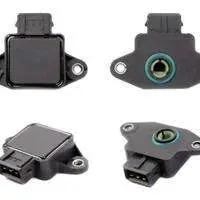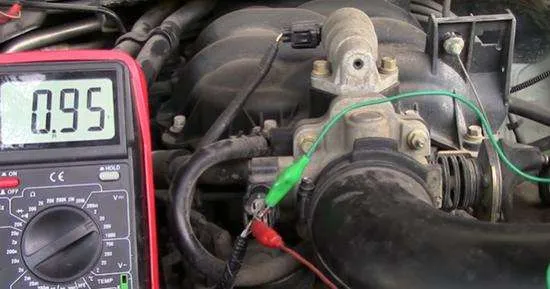A throttle position sensor is necessary for the engine’s correct amount of fuel and air mixture combustion. A faulty throttle position sensor results in a poor fuel average and irregular acceleration. So it’s necessary to test your throttle position sensor with a multimeter to evaluate the functioning of the sensor.
Table of Contents
ToggleHow the throttle position sensor works
A throttle position sensor monitors the throttle’s position and sends the information to the engine. It controls the amount of air entering the engine.
The throttle position sensor controls the engine’s air entering to make the air-fuel mixture needed for combustion. When the accelerator is pressed, the throttle valve opens and intakes an amount of air, depending on the pressure on the accelerator.
The throttle position sensor monitor’s how much the throttle valve is open upon pressing the accelerator.
A throttle position sensor moves with the throttle valve movement and sends that data to the computer that calculates the fuel delivery engine load and the adjusted timing.
Signs of a bad throttle position sensor
- Irregular acceleration and uneven idle
- Dropped Fuel Economy
- Lacking power when accelerating
- Check Engine light is on without a visible reason
- Vehicle runs slow
- The engine is revved-up continuously
How to test throttle position sensor with a multimeter
To test the throttle position sensor:
- Locate the throttle sensor and disconnect the connector.
- Set your multimeter to DC voltage at 20V.
- Check the voltage in the live (red) and signal (black) wire with reference to the ground wire.
- Also, test the ground sensor wire along with the positive battery terminal.
- The voltage in the throttle position sensor’s live (reference) and signal wire should be 5V when the valve is fully open.
- Also, test the resistance in the sensor terminals while rotating the sensor in the clockwise and anticlockwise direction.
- The voltage reading should equal the battery’s voltage from the positive battery terminal to the throttle ground connection.
- A throttle position sensor can have 3-6 wires coming from the connector to the sensor. A three-wire throttle sensor has a ground wire (brown), a live wire carrying voltage from ECU(red), and an output signal wire carrying 0-5V from the sensor.
Locate the Throttle position sensor
First of all, locate the throttle position sensor. Throttle valves are located near the throttle valve inside the body, on the intake manifold entrance, or inside the body itself. View the installation diagram of your vehicle’s model.
Test the Throttle position sensor’s ground terminal
First, we’ll test the ground connection in the throttle position sensor.
- Disconnect the throttle position sensor connector.
- Turn your vehicle in the on position.
- Locate the ground wire in the connector; it is green-colored.
First of all, we’ll test the ground wire in the sensor. Set your multimeter to DC voltage at a low range, such as 20V.
Connect the red probe to the positive battery terminal. Connect the black probe to the ground terminal in the connector (the other connector where the throttle position sensor gets connected). You can also connect the black probe to the ground point of the throttle position sensor or the throttle body.
The ground connection in the throttle position sensor is fine, and the multimeter will read 12V (equal to the battery’s voltage). If the voltage reading drops up to 10V, it could be due to the damaged ground wire or the battery needing to be fully charged.
You can also check continuity in the ground terminal of the throttle position sensor. Set your multimeter to ohms. Connect one probe to the battery’s negative terminal and the other probe to each terminal in the sensor connector.
The ground wire is the wire (terminal) that shows continuity with the negative battery terminal. The resistance in the ground wire should be near 0 ohms.
Test the Voltage in reference Terminal
The reference or live terminal in the throttle position sensor carries current from the ECU and delivers it to the live terminal in the sensor. Usually, the voltage in the reference or live terminal is around 5V.
Set your multimeter again to DC voltage at 20V range. Turn the ignition key to the on position.
Connect the red probe to the live/reference terminal. The black probe is connected to the terminal in the other connector where the ground wire from the throttle position sensor gets connected.
When the throttle valve is completely open, your multimeter should read around 5 V; that’s the ideal voltage from the ECU to the throttle sensor. The connector’s live wire is damaged or corrupted if your multimeter reads quite low voltage.
Test voltage in the Signal Wire
A signal wire should be precisely working to determine the exact position of the throttle and send it to the computer. For proper working, the signal wire should output the ideal voltage. We’ll again test the voltage of the signal wire with a ground reference.
- Make sure that the vehicle ignition is in the ON position
- Connect the red probe to the signal wire (black) in the sensor connector and the black probe to the sensor’s ground wire (green) or any ground terminal in your car.
- When the throttle valve is completely closed, you can expect a voltage reading of around 1-1.5V.
- When the throttle valve is opened, your multimeter should read around 5V.
Identify poor throttle position sensor with multimeter readings.
If the multimeter reading increases quickly while the throttle valve is opening. Multimeter reading may get stuck while increasing or decreasing.
If the voltage is below 5V, even after the valve is completely opened.
How to bench test the throttle position sensor?
You can test a throttle position sensor out of the engine. Disconnect the sensor from the connectors. Take your multimeter and set it to resistance. Connect one probe to the central terminal in the sensor and the other probe to one of the remaining terminals.
Use a screwdriver to rotate the sensors from opposite sides of the terminals. When you rotate the sensor, clockwise resistance will increase up to 470-500, varying in different models. When you rotate the sensor anticlockwise, the resistance will decrease.
In another way, disconnect the throttle position sensor from the connector. Please turn on the engine and start it after 30 seconds. Your vehicle will start, but the acceleration will drop. It means that the throttle sensor is fine.
Frequently Asked Questions
What happens if you disconnect the throttle position sensor?
Without a throttle position sensor, your car will start. Still, your vehicle will face several issues, such as poor fuel average, no power in the engine, the engine getting revved up, and the acceleration varies.
The engine control unit cannot detect how much fuel mixture should be burnt to run according to the speed variation.
Can you bypass the throttle position sensor?
Yes, you can bypass a throttle position sensor, but it won’t be worth you. Without a TPS, your engine control module will burn more fuel, disturbing your fuel economy, and excess fuel combustion stores carbon in your engine and exhaust.
How to test a 4-pin throttle position sensor?
In a 4-pin throttle position, the rightmost is for the ground wire. The second terminal is for the idle switch signal, the third is for the throttle valve signal, and the last is for the live wire supplies 5V.
The idle signal terminal sends the signal to the computer when the throttle valve is fully closed.
When the throttle valve is entirely closed, the signal wire has .3-.9 voltage, and ECM determines that the throttle sensor is closed.
Conclusion
A throttle position sensor is essential to run your vehicle ideally. With a good throttle position sensor, you’ll face poor average and varying acceleration, and the engine will have the power to run the car.
A multimeter easily tests a throttle position sensor by measuring voltage and resistance in the throttle position sensor terminals. Compare the multimeter reading with the ideal range of your vehicle’s sensor model.
Follow the complete guide from the beginning to test your vehicle’s throttle position sensor with a multimeter.
Related Guides






